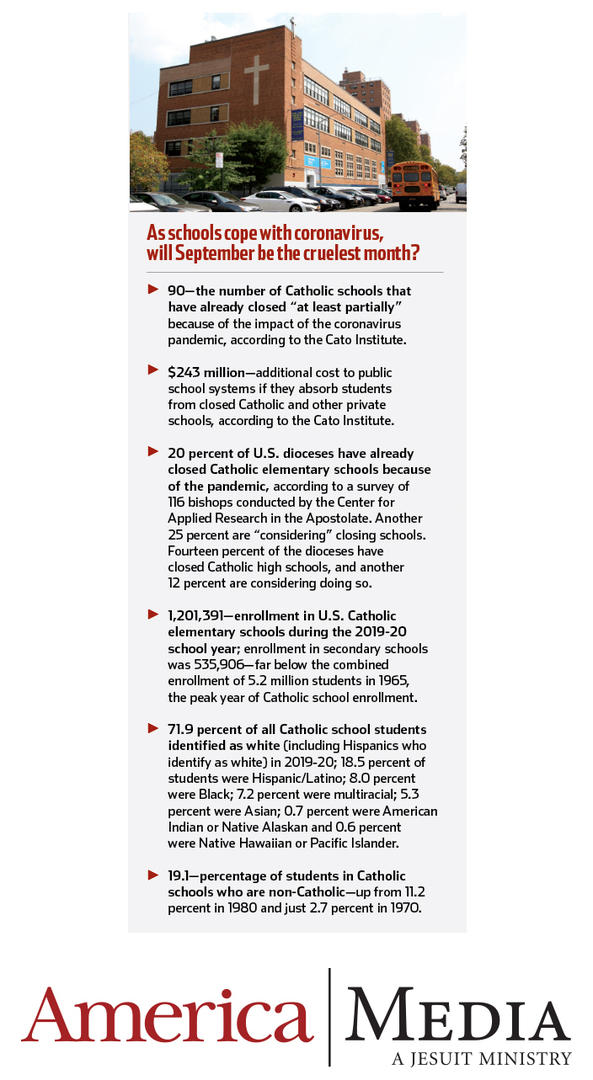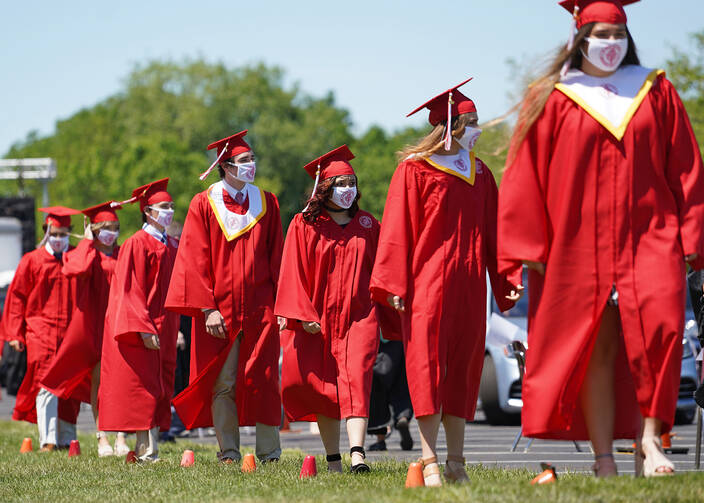For the roughly 1.75 million students enrolled in Catholic schools throughout the United States and their parents—especially their parents—news about what school will look like in September cannot come soon enough. But as the number of coronavirus cases continues to rise in most states, school administrators are still struggling to decide if classes can be held in person, if remote learning is here to stay for a while or if a hybrid of the two is needed. All that uncertainty makes planning difficult.
“It’s not like when you have a hurricane come rolling through or an earthquake or some major damaging event,” said Kevin Baxter, the chief innovation officer for the National Catholic Education Association. “It’s just the unknown, planning contingency upon contingency upon contingency.”
What schools and parents want may not be possible, as safety remains a priority.
“Schools are trying to think about how to start next year. They want to be in-person, they want to have kids back, but a lot of that’s going to be driven by the reality of their specific geographic region,” Mr. Baxter added.
By July 9, according to the N.C.E.A., 10 Catholic school systems had said they planned to resume in-person teaching this fall, including two of the nation’s largest systems in the Archdiocese of Los Angeles and the Archdiocese of Chicago. The Archdiocese of Los Angeles stated in a letter on June 15 that opening this fall will require a number of safety measures, “such as physical distancing; facial coverings; frequent hand washing; keeping students in class-level cohorts; use of outdoor spaces for instruction; and non-touch temperature checks upon entry among others.”
As the number of coronavirus cases continues to rise in most states, school administrators are struggling to decide if classes can be held in person, if remote learning is here to stay for a while or if a hybrid of the two is needed.
As California faces a surge in coronavirus cases, the Los Angeles Unified School District announced on July 13 that it would begin classes online next month and could return to in-person learning depending on how the fight against the virus progresses. A statement from the Archdiocese of Los Angeles on July 14 said that Catholic schools plan to reopen in the fall.
“The Department of Catholic Schools is actively monitoring the situation and is in communication with the various county public health,” the statement read. “Given the situation and the on-going changes our schools continue to prepare for both in-person and distance learning.”
(UPDATE July 20: The Archdiocese of Los Angeles announced on July 18 that L.A. Catholic schools will resume in the fall using distance learning, delaying plans to reopen with in-person classes. The decision follows Gov. Gavin Newsom’s new statewide rules for resuming in-person teaching.)
“I think the protocol [the L.A. archdiocese] put in place—with taking [students’] temperature, not penalizing if they’re sick and need to stay home, doing some social distancing...educating outside—is good,” said Leah Niehaus, a parent of three whose daughter is a Catholic high school student in Los Angeles. But she worries that it will be difficult for students to wear masks all day. “They’re trying to build in some breaks, and they’re also going to do all these cleaning protocols.”
Rebecca Foster is concerned about “the mental health toll” the experience of being kept out of school has had on her son Johnny, “not being around peers and friends and socializing.”

“I would much rather take on the risks of what it means to have a kid in a classroom all day than have him home all day,” said Mrs. Foster, a Manhattan Beach, Calif., parent whose son is about to start 8th grade at American Martyrs School. “I just think it’s really hard for a middle school boy to be home all day without interaction with peers.”
In this parent’s assessment, the school experience is “20 percent about reading and writing and it’s 80 percent figuring out how to be a member of society through interactions with other adults and other students and all the other things that school is. And that’s what we’re missing out on.”
In New Jersey, one of the states hardest hit in the first few months of the Covid-19 pandemic, St. Matthias School in Somerset plans to reopen for a full five-day school week, with mandatory masks for students and staff, social distancing and multiple cleanings each day. Elena Malinconico is the principal of the K-8 school, which serves more than 350 families.
“Children need that socialization, especially younger kids,” Ms. Malinconico said about the decision to reopen. “The distance learning was fabulous, but we lost a lot because they were just not capable at their age to do virtual learning.”
Catholic schools, she added, also have a commitment to community, family and faith, which is difficult to maintain in a remote learning environment. She said that conversations about recent news related to racial justice are essential to hold in person. But, Ms. Malinconico said, the plan to reopen remains “fluid” and that “the ultimate goal is the health and well-being of our students.”
Catholic schools have a commitment to community, family and faith, which is difficult to maintain in a remote learning environment.
Children are less likely to become seriously ill than adults, and there is little evidence that they are driving transmission, Jennifer Nuzzo, an epidemiologist at Johns Hopkins University’s Covid-19 Testing Insights Initiative told The Associated Press. Still, there is a risk they could transmit the virus to others, including teachers or vulnerable people they live with.
“That is a reason to think about how to improve safety and to reduce the risk in school environments,” Ms. Nuzzo said. “Those measures and the move to reopen schools should proceed before the higher risk environments” like bars, restaurants, gyms and other indoor spaces.
If transmission can be reduced in the wider community, she said, it will make it safer for schools to reconvene. “We should be prioritizing the reopening of those public spaces that have known benefits and low risks,” Ms. Nuzzo said, “and we think that schools are one of those.”
So far, at least, the number of Catholic schools that have announced they are closing or consolidating before the next academic year is similar to that of the previous few years, which is usually just under 100, though that figure is typically reached over the course of the school year.
“We have all these schools closing, but sadly that’s been the reality for Catholic schools the last number of years,” Mr. Baxter said. But he said he worries about what happens if the economic slowdown related to the pandemic continues.
“What I’m thinking about more is the long-term, the year from now, the end of the 2020-21 school year, if the economy doesn’t come back in any measurable way that the impact could be more significant,” he said.
Mr. Baxter, a former superintendent of Catholic schools in Los Angeles, said that many Catholic schools are supported by parishes, many of which are facing daunting budget challenges after being closed for several weeks and reopening with limited capacity. Besides, parishes ultimately support dioceses, which also offer some support to schools.
According to the Cato Institute, 91 Catholic schools have already shuttered “at least partially” because of the economic impact of the coronavirus pandemic.
According to the Cato Institute, 91 Catholic schools have already shuttered “at least partially” because of the economic impact of the coronavirus pandemic. Catholic schools’ “razor-thin financial model,” its researchers said, “is proving very difficult to sustain as the coronavirus has led to school and church shutdowns—and hence big fundraising drops—and as tuition-paying families face their own virus-related financial problems.”
On July 9, the Diocese of Brooklyn announced six of its schools would close at the end of August, and the Archdiocese of New York announced that 20 of its elementary schools would not reopen in the fall and that three others would consolidate because of the various economic impacts of the pandemic. According to the archdiocese, spiking unemployment and continuing health concerns left New York families unable to pay current tuition and resulted in a significantly lower rate of re-registration for the fall. Months of canceled public Masses and fundraising for scholarships have led to a loss of parish contributions that traditionally help support the schools.
“Children are always the most innocent victims of any crisis, and this Covid-19 pandemic is no exception,” Cardinal Timothy Dolan, archbishop of New York, said in the statement. “Too many have lost parents and grandparents to this insidious virus, and now thousands will not see their beloved school again. I’ve kept a hopeful eye on our schools throughout this saga and my prayers are with all of the children and their families who will be affected by this sad news.”
Michael J. Deegan, the superintendent of schools for the archdiocese, said that if Congress does not pass another stimulus bill like the Heroes Act passed by the House in May, more damage to the system may be forthcoming. That bill, passed along a party-line vote with just one Republican supporting it, includes $3 trillion in stimulus money, including direct payments to families, but Republican leaders have signaled that they think the cost is too high. Treasury Secretary Steven Mnuchin, meanwhile, said on July 9 that the White House is committed to passing another stimulus package before the end of the month.
Though Mr. Baxter said many parishes believe they can support their schools during a difficult year ahead, support levels beyond that are less certain. In addition to likely weakened fundraising from parishes and dioceses, there are also questions about whether parents will be willing to pay full tuition in the event that schools transition exclusively to online learning.
“The next six to eight months are going to be really telling in terms of where the economy is to see the ultimate effect on Catholic schools,” he said.
Still, despite the challenges ahead, he has been heartened by the response of many Catholic schools and systems to the pandemic. For one, he said many schools have effectively used technology to foster a sense of community even while students were learning from home.
Mr. Baxter said he has been in touch with school leaders in many communities to talk about what opportunities may arise from the disruption caused by the virus, especially for schools that were stable before the coronavirus hit.
“Can we restart some schools, in a year or maybe two years, with a new curriculum model or some new approach to governance structure?” he asked. “We should be able to kind of reignite and restart.”
Sources for sidebar: Except as noted, all data is from “United States Catholic Elementary and Secondary Schools 2019-2020,” the latest edition of the annual statistical report from the National Catholic Educational Association. Number of dioceses reopening so far based on information from the N.C.E.A.
With reporting from editorial interns Maeve Orlowski-Scherer and Gaby Guerrero
Correction July 17, 2020: Leah Niehaus’ first name was misspelled in an earlier version of this report. America regrets the error.
Correction July 14, 2020: St. Matthias School in Somerset, N.J., is K-8, not K-12 as originally reported. America regrets the error.








